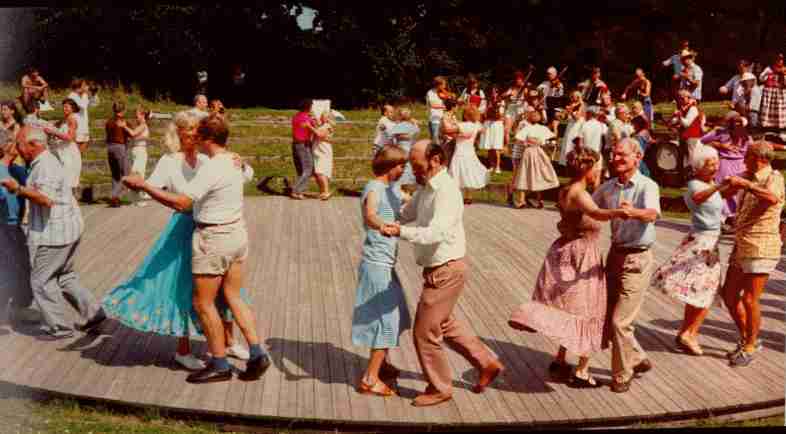
Høstdans (Harvest Hopsa) |
| Niels Mejlhede Jensen, Bøgeløvsvej 4, 2830 Virum, Denmark. e-mail (web master) |
CONTENTS: (remember: you can use Ctrl Home in usual browsers to get to the top of this page, to the links here)

Photo of this week: The dance of this week, hopsa, danced at
the Open Air Museum (Northern Copenhagen Metropolis). This museum shows
many farm houses and buildings from the rural old Denmark, spread over
a big area, my favourite museum. On this photo Spillemandsdansen (Fiddlers'
Dance) is playing here a sunday in august, inviting the visitors to participate
in the dance. Spillemandsdansen has the tradition to play here and invite
everybody to come and dance every 2' day of Pentecost (Whit monday), i.e.
monday following Pentecost Sunday in May or June (2' pinsedag).
Hopsa is a fast dance and demands energy. So do not repeat the
music more than once, or not at all. (I sometimes play it even a little
faster than given here). We often have a hopsa to end a group of dances.
So in Spillemandsdansen we have two hopsas an evening with 30 dances: one
before the coffee break and one before going home. Hopsa is physically
demanding, but you can "cheat", specially as a gent. We have another energetic
dance: "galop", which is very rare now a days here in Copenhagen. There
you cannot cheat. When I did research for my family genealogy book (my
roots) on the island of Mors, I was told of my long deceased grandfather
that he as young was notable good in dancing a beautiful galop. So that
was what would count 90 years ago.
Dance of the week, 1999, February 15:
The melody can be heard in midi on computer piano in my tempo (if you
have a sound card). (The melody will loop here until you stop it. In the
table below it will play once). (I have not played the tunes here with
the "drive" I want for dance music).
| 1 | melody | the traditional good dancing melody, polished through generations of use on the fiddle | |
| . | chord
text |
Midi metronome = 180 | simple (folk music) chords, natural for playing the accordion;
these chords are used to make the other parts or voices in triad harmony; there should be no tension from dissonance anywhere including in octavo |
| 2 | A | (Above), parallel part nearest above in third or little more above | |
| 3 | B | (Below), parallel part nearest below in third or little more below | |
| 4 | ns | simple n part; often with the tonic feeling and often with the basic dance rhythm ("motor part"); n is a less constricted part, and tones from the melody are freely included | |
| 5 | C1 | C parts are made from A and B parts, and so they are two parts to the melody | |
| 6 | C2 | C2 is less simple than C1 | |
| 7 | mod =
contra part |
voice up and down (mostly) contra to the melody; it is also made from A and B | |
| 8 | n1 | n is a less constricted part, and tones from the melody are freely included | |
| 9 | C1 | C1 in octavo down | |
| 10 | C2 | C2 in octavo down | |
| 11 | n1 | n1 in octavo | |
| 12 | blank | . | blank staff for making your own part according to the principles here |
(The midi music is not repeated, except for 1' and 2' voltas).
Use also octavo, up and down.
Where wanted, notes can be changed according to the principles (use
a colour pencil), e.g. to improve the B part with some notes from
A.
The music is aimed at dancing, so part of the orchestra can be the
underlying "motor" when another instrument group is playing its "solo"
part (improvisation) as one of the many repetitions.
The double bass may play its usual notes, because of its low pitch.
It is better to choose a more simple part and play it well.
Accordion: beats per bar: 2+2 (light after beat); if that is
too fast for you then: 1+1 (more equal beats). Beat 1 is well marked.
(Help coming back from that note
sheet: CLICK note sheet to come back to this page, or just close note
window.
Remember: the note sheet opens in a new separate window, and that may
cover the whole screen. The back button in the tools bar does probably
not work because the window is new, with no history. All you see on the
page are notes because I have placed no link back here for not disturbing
easy submitting to the printer. Close the note window with a click at the
top or with Alt F4, or minimize or reduce the window, or ..., and you are
back to the main page that was there behind all the time).